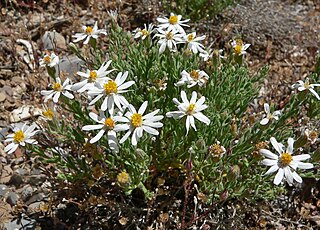
Anisocoma acaulis, commonly known as the scale bud, is a wildflower found in the Mojave, Colorado Deserts, and California's Owens Valley above 610 metres (2,000 ft), up to about 2,100 m (7,000 ft).

Zinnia acerosa is a low-growing perennial flowering plant native to the Southwestern United States and Northern Mexico. Common names include desert zinnia, wild zinnia, white zinnia, and spinyleaf zinnia. It is a popular landscape plant in the southwest due to its low water use and long bloom period. The flowers also serve as a food source for southwestern butterflies.

Chaenactis is a genus of plants in the family Asteraceae which are known generally as pincushions and dustymaidens.

Chaetopappa is a genus of plants in the family Asteraceae which are known generally as leastdaisies.

Acourtia microcephala is a species of flowering plant in the family Asteraceae known by the common name sacapellote. It is native to southern California and Baja California, where it grows in woodland and chaparral, especially in the coastal mountain ranges.
Clappia suaedifolia is the sole species in the North American genus of flowering plants in the family Asteraceae, Clappia.
Agave palmeri is an especially large member of the genus Agave, in the family Asparagaceae.

Agave xylonacantha is a plant species native to Hidalgo, Tamaulipas, Guanajuato and Queretaro in Mexico, but commonly cultivated as an ornamental on other regions. A. xylonacantha is an easy-to-grow member of the genus Agave. The specific epithet 'xylonacantha' means "wood spines".

Agave striata is a plant species native to Northeastern Mexico. Because the species is widespread and does not appear to be under any significant threats, it is not considered by the IUCN to be threatened.

Bletia purpurea, common name pine-pink or sharp-petaled bletia, is a species of orchid widespread across much of Latin America and the West Indies, and also found in Florida. They are terrestrial in swamps or sometimes found growing on logs or stumps above the high tide mark.

Erythrina flabelliformis, common name chilicote or western coral bean, is a plant species native to central and northwestern Mexico and the southwestern United States. It is known from Baja California as far south as Morelos and as far east as San Luis Potosí, as well as from Arizona and New Mexico.

Baccharis pteronioides is a North American shrub in the family Asteraceae known by the common name yerba de pasmo. It is widespread in Mexico and also found in the southwestern United States.

Baccharis thesioides is a North American species of shrubs in the family Asteraceae known by the common name Arizona baccharis. It is widespread in Mexico from Chihuahua to Oaxaca, and also found in the southwestern United States.

Cirsium texanum is a species of plant in the tribe Cardueae within the family Asteraceae found in North America. Common names include Texas thistle, Texas purple thistle or southern thistle. The species is native to northern Mexico and the southern Great Plains of the south-central United States. It grows in prairies and roadsides.
Cosmos pacificus is a Mexican species of plants in the family Asteraceae. It is native to southwestern and west-central Mexico from Sinaloa to Chiapas.
Cosmos sherffii is a Mexican species of plants in the family Asteraceae. It has been found only in the state of Oaxaca in southern Mexico.
Cosmos longipetiolatus is a Mexican species of plants in the family Asteraceae. It has been found only in the state of Jalisco in southern Mexico.
Erigeron jamaicensis is a Caribbean and Mesoamerican species of flowering plant in the family Asteraceae commonly called Jamaican fleabane. It is native to Mexico, Central America, and the Greater Antilles.

Erigeron tracyi is a North American species of flowering plant in the family Asteraceae known by the common name running fleabane. It is native to northern Mexico and the southwestern United States.
Tagetes foetidissima is a Mesoamerican species of marigolds in the family Asteraceae. It is widespread across much of Mexico and Central America from Tamaulipas to Costa Rica. Common name is "flor de muerto," Spanish for "death flower."













